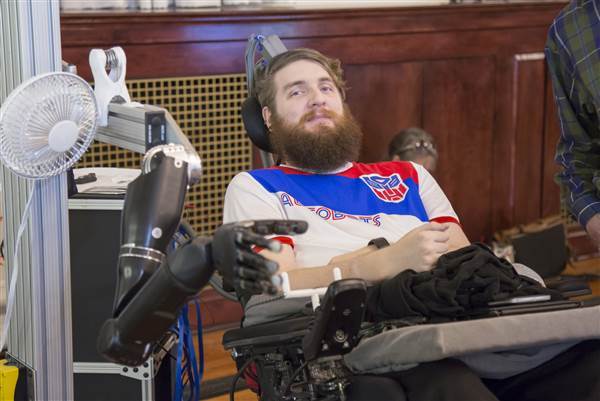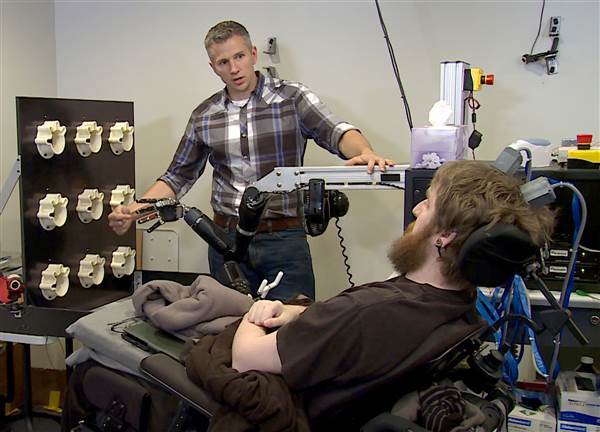An implanted brain chip is helping Nathan Copeland feel his fingers for the first time in a decade.
Copeland, who lost all feeling and movement from the chest down after a car accident in 2004, can also “feel” the fingers of a robotic arm using the chip.
He showed it off Thursday by fist-bumping President Barack Obama.
“Let’s see what you got,” Obama said after meeting Copeland at a science event organized by the White House in Pittsburgh.
“That is unbelievable,” Obama added. “Nathan is moving his hand with his brain.”


Copeland’s the latest patient helping test brain interfaces being designed by a team at the University of Pittsburgh Medical Center.
“I can feel just about every finger. It’s a really weird sensation,” Copeland, 30, said in a statement released by the university.
“Sometimes it feels electrical and sometimes it’s pressure, but for the most part, I can tell most of the fingers with definite precision,” he said. “It feels like my fingers are getting touched or pushed.”
It’s actually a series of chips that are helping Copeland feel again, and control a robotic arm with a specially designed robotic hand with sensors that relay electronic impulses to Copeland’s brain.
“I can feel just about every finger. It’s a really weird sensation.”
The experiment, described in a report in Science Translational Medicine, is the latest coup from the UPMC working to restore a little life to people otherwise unable to move much on their own.
Related: New Bionic Hand Restores Sense of Touch
They’ve also been working with Jan Scheuermann, paralyzed by a degenerative disease, who’s tried out a variety of thought-controlled robotic arms. Other teams are also working on thought-controlled prostheses for people.
“Slowly but surely, we have been moving this research forward,” said Dr. Michael Boninger, a professor of physical medicine and rehabilitation who is part of the team.
“The ultimate goal is to create a system which moves and feels just like a natural arm would,” said Robert Gaunt, another team member.
Related: 8 Paralyzed patients Regain Feeling and Movement
For Copeland, it took months for his brain to even be able to interpret the signals.
“During the initial weeks after implant, the participant reported spontaneous sensations in the absence of electrical stimulation, often described as tingling, occurring throughout his right hand and arm, which were of moderate intensity and frequency but not bothersome,” the team wrote.


Then he reported being able to feel actual contact.
“It’s almost like if you pushed there, but I didn’t quite feel … the touch,” the report quotes Copeland as saying.
Most important, the sensations did not feel like “pins and needles” but was far more complex and natural feeling, the team said.
Related: Nerve Implants Let Patients Feel Artificial Fingers
He cannot feel hot or cold yet but when someone presses on the robotic fingers, Copeland can identify which finger is being touched, the team reports.
Copeland had been a budding scientist before his accident, studying nanofabrication. Now he’s taking part in his own, real-life science experiment.
Related: Woman Uses Thought Control to Eat Chocolate
“Luke Skywalker got his hand chopped off, and the next day he has a robot one,” Copeland says in a video released by Pitt.
“That could be someone else, not even that far in the future.”







